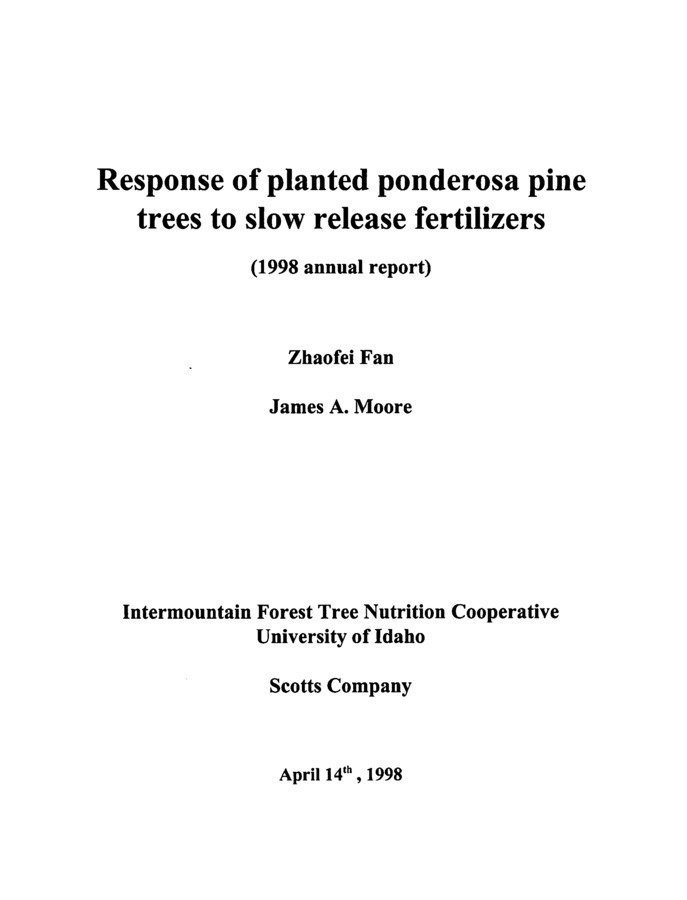PDF
Response of Planted Ponderosa Pine Trees to Slow Release Fertilizers Item Info
- Title:
- Response of Planted Ponderosa Pine Trees to Slow Release Fertilizers
- Creator:
- Fan, Z.; Moore, J.A.
- Date Created (ISO Standard):
- 1998-04-14
- Description:
- Nutrient availability has long been recognized as a limiting factor to plant growth (Luxmoore et al. 1993). In the Pacific Northwest, of the elements needed for tree growth, nitrogen is the only one that is consistently deficient in the forests of the Northwest (Cole, et al., 1992). Foliage samples collected from 90 fertilizer trials in Douglas-fir scattered across eastern Washington, northeastern Oregon, Idaho and western Montana showed nitrogen concentrations of unfertilized trees to be quite low throughout the area (Mika and Moore, 1990). Foliar analysis has also shown severe to very severe nitrogen deficiencies to be common in lodgepole pine stands throughout the interior of British Columbia (Ballard, 1986) and in many ponderosa pine (Powers et al. 1988) and true fir (Powers, 1981) stands in California and Oregon. No other nutrients have been found generally lacking over such large areas and wide range of conditions. Since early work by the College of Forestry, University of Washington, in the1950's, wide-scale testing with nitrogen has been used to develop response predictions. Currently, however, most information on application rates has been based on broadcast application of soluble nitrogen sources. Very little or no information is available on effects of slow release sources on growth of ponderosa pine, especially using a dibble technique. Therefore, the objectives of this study are: 1) to determine the optimum rate of a complete fertilizer to assure rapid tree establishment and early development during the first four years following outplanting; 2) to evaluate the effects of different nutrient release characteristics on plant performance, especially on the root system and 3) to determine correlation of nutrient concentrations from tissue analysis with nutrient application rate and seedling growth rates. The experiment, if successful, will provide a practically economic and efficient fertilization method to ensure rapid growth and a higher nutrient uptake rates of after planting ponderosa pine.
- Subjects:
- research (document genres) fertilizer timber (lumber) statistics
- Location:
- North and Central Idaho; Eastern Washington; Western Montana; Northeastern Oregon
- Publisher:
- Intermountain Forest Tree Nutrition Cooperative, University of Idaho, College of Forest, Wildlife and Range Sciences, Moscow
- Source:
- Fan, Z., J.A. Moore, 1998. Annual Report, Response of planted ponderosa pine trees to slow release fertilizers. IFTNC, FWR, Univ. of Idaho, Moscow.
- Source Identifier:
- Response_of_Planted_Ponderosa_Pine_Trees_to_Slow_Release_Fertilizers_IFTNC_1998
- Type:
- Text
- Format:
- application/pdf
- Language:
- eng
Source
- Preferred Citation:
- "Response of Planted Ponderosa Pine Trees to Slow Release Fertilizers", Idaho Forestry Research Collection, University of Idaho Library Digital Collections, https://www.lib.uidaho.edu/digital/forestryresearch/items/forestryresearch900.html
Rights
- Rights:
- In copyright, educational use permitted. Educational use includes non-commercial reproduction of text and images in materials for teaching and research purposes. For other contexts beyond fair use, including digital reproduction, please contact the University of Idaho Library Special Collections and Archives Department at libspec@uidaho.edu. The University of Idaho Library is not liable for any violations of the law by users.
- Standardized Rights:
- http://rightsstatements.org/vocab/InC-EDU/1.0/

